
|
 French Riverine CraftUpdated 09/01/2005:
added Army-operated riverine craft |
||||||||||||||||||||||||||||||||||||||||||||||||||||||||||||||||||||||||||||||||||||||||||||||||||||||||||||||||||||||||||||||||||||||||||||||||||||||||||||||||||||||||||||||||||||||||||||||||||||||||||||||||||||||||||||||||||||||||||||||||||||||||||||||||||||
Related Pages: |
LCT Mk.4 (Landing Craft Tank, Mark 4) [ Top ] This large British landing craft was the workhorse of the Navy's river transport force and saw constant use, mainly in Tonkin. They were often referred simply as "long LCTs" as opposed to the shorter American LCT (6). Whether carrying men, vehicles and supplies during major operations or building materials to establish new river outposts, these boats were found to be well adapted to local conditions and became very popular. Their usefulness was in fact the main drawback : the second-hand market in South-East Asia dried up rapidly as they were much sought after by civilian shipping companies and there were never enough of them. A number were operated by civilian companies in Indochina and these were often requisitioned during major operations. For use in Tonkin, their initial armament of two 20mm Oerlikon guns was typically increased to one 40mm Bofors, three 20mm Oerlikons and two 81mm mortars. By the end of the war though, LCT 9069 boasted two 75mm field guns, two 40mm Bofors, two 20mm Oerlikons, two 12.7mm machine guns and one 120mm mortar.
LCT (6) (Landing Craft Tank, Mark 6) [ Top ] Used exclusively for operational and logistics transport in Cochinchina and Cambodia, these American landing craft were often referred simply as "short LCTs" as opposed to the longer British LCT Mk.4 . One of the five craft was converted to a floating workshop.
LCI (Landing Craft Infantry) [ Top ] US landing craft designed to carry the second wave's infantry to the beach, they were fitted with increased armament and communications fit and used as command ships for the Dinassauts. Well liked, these veterans of WW2 were nonetheless quite worn by 1951 when they began to be replaced by more modern LSILs.
LSIL (Landing Ship Infantry, Large) [ Top ] US developments of the LCI, these were designated LCI(L) in WW2. The main difference compared to its predecessors were the replacement of the side ramps by a bow door, slightly different armament and more modern radios. Armour protection for the bridge and the sides of the 76mm gun's deck was added by local workshops. Good living conditions made these ships very popular with their crews.
LCG (Landing Craft, Gun) [ Top ] This British fire support version of the LCT Mk.IV boasted a heavy artillery armament but was found to be less versatile than the LSSL. The sole LCG used in Indochina was assigned to Cochinchina throughout the war.
LSSL (Landing Ship Support, Large) [ Top ] Designed at the close of WW2 to provide close fire support and anti-aircraft protection for landing operations, these ships, nicknamed "river cruisers", were the most powerful units on the rivers. Often used for lone raids or patrols, they normally cooperated with the Dinassauts for specific operations because of their heavy firepower and extensive command and control capabilities. Named Arbalète, Arquebuse, Hallebarde, Javeline , Pertuisane and Rapière, the first six only underwent minor modifications such as the addition of two mortars and armouring of conning and radio rooms and of the bridge. The second series (Framée , Etendard and Oriflamme), delivered in late 1953 and early 1954 had the 76mm gun replaced by a single 40mm Bofors and two banks of rocket launchers added. Arquebuse, Javeline and Framée were turned over to the South Vietnamese Navy and the other boats returned to the USN.
LCM Monitor [ Top ] Converted from regular LCMs by the Saigon Arsenal when the need for additional firepower became clear, these craft had their bow ramp removed and turrets from obsolete Coventry armoured cars were fitted in addition to a mortar in a central tub. In order to allow observation over the dikes which lined most of the rivers, a crow's nest was initially fitted over the stern but quickly removed because the observer's life expectancy in case of ambush was very short ! The monitors were mainly used in Tonkin where they provided the Dinassauts with heavy organic fire support. Although powerful and well protected, they were far from immune to the growing Viet Minh frepower. The surviving craft were turned over to the South Vietnamese Navy in 1955. The LCM Command boat was closely related.
LCM Command Boat [ Top ] Another Saigon Arsenal conversion of the LCM hull closely related the LCM Monitor, these replaced LCIs and LSILs used as Dinassaut command boats in areas inaccessible to the larger craft. Their limited armament was meant for self-defence and indirect fire support and their value lay in the extensive command and control capabilities. Mainly used in Cochinchina, these late additions to the Dinassauts were transferred to the South Vietnamese Navy and saw most of their service after the First Indochina War.
LCM 6 [ Top ] An enlarged version of the LCM 3, the LCM 6 was the probably the model that was the most heavily modified for use on the rivers. By 1950, a standardized conversion made these boats quite versatile with their combination of large carrying capacity (four of them could carry one battalion), heavy firepower and good protection. Living conditions, however, remained very difficult especially on long patrols. Some of these LCMs, were also built from the keel up by the Saigon Arsenal. Usually referred to as "long LCMs" or "heavy LCMs" although the second term was also sometimes used for all armoured LCMs.
LCM 3 [ Top ] True workhorse of the Dinassaut, the LCM was used for transport, patrol and just about any mission that could be given to a boat. Although protection was at first limited to sandbags and the armament to the original two 7.62mm machine guns, by 1950 a nearly standardised model was starting to emerge with the stern encased in armour and much heavier armament (the photo below shows an interim model lacking the stern 20mm Oerlikon). The precise breakdown between this model and the LCM 6 is impossible to establish since the French Navy didn't classify them separately. Usually referred to as "short LCMs", they were sometimes described as "light LCMs" although this term could also be used for any unarmoured LCM.
LCM Mk.1 [ Top ] At least eight of these British landing craft were bought from the Royal Navy in Singapore in 1945 and used in Tonkin for transport work. Shorter and less capable than the later LCM models, these were rapidly relegated to the relatively static river outpost forces notably because their instability made it impossible to fit armour or a heavier armament. Appreciated for their relatively silent petrol engines, they were nevertheless prone to accidental fires which destroyed a number of boats.
LCA (Landing Craft Assault) [ Top ] These British landing craft, designed to carry an infantry platoon to the beach, were obtained from Royal Navy stocks in Singapore and used as patrol and assault craft until 1951. Well liked for their armour protection and relatively silent engines, slow speed and lack of endurance were their main drawbacks. Most were armed with a rear-facing 12.7mm heavy machine gun and two .303 Lewis guns (later replaced by less antiquated machine guns) and fitted with an overhead canvas cover to provide some protection from rain, sun and grenades. As more LCVPs arrived, these seem to have been passed on to the river outposts.
LCS(M) (Landing Craft Support, Mortar) [ Top ]
LCVP (Landing Craft Vehicle Personnel) [ Top ] This US equivalent of the LCA was widely used as a patrol and fire support craft and later as a minesweeper. Locally armoured and armed with one 20mm Oerlikon gun, three 7.62mm machine guns and two rifle grenade launchers, this was one of the most common craft on the rivers although it was found to be too slow, unwieldy and noisy for effective patrol work. Living conditions aboard the cramped LCVPs were particularly difficult. Despite its drawbacks, its usefulness prompted the French Navy to build its own steel copy, the EA (Engin d'Assaut).
EA (Engin d'Assaut - lit. Assault Craft) [ Top ] A French copy of the LCVP, the EA's only advantage over its US model was an all-steel construction which made it a sturdier craft. However, this also made it much heavier and even more unwieldy since it used the same Gray Marine diesel engine as its predecessor. It carried the same armament as the LCVP though the layout was slightly different and the 20mm gun was a German MG 151 which was found to be more reliable. Mainly used for patrols, ambushes and minesweeping it was much less suited to these roles than the FOM boats.
VP (Vedette de Port - Harbour Defence Motor Launch - HDML) [ Top ] Although not actually part of the Dinassauts, British HDMLs were extensively used on the rivers. Once their armour and armament was increased, these boats proved very useful for lone patrols or as escorts for river convoys. Designed for patrol work, unlike most of the other craft, they offered a good combination of firepower, protection, communications fit and living conditions although their rather large draught restricted their use. Two unarmoured HDMLs were also used for coastal patrols.
MFV (Motor Fishing Vessel) [ Top ] A handful of these fishing trawlers converted for coastal patrols during WW2 were used for patrols and raids along the Viet Minh-held coasts or estuaries although they were never part of the Dinassauts.
YTL (Small Harbour Tug) [ Top ] These converted tugs supplied by the USA were mainly used by the Groupe de Dragage du Mékong (Mekong Minesweeeper Group) as river minesweepers. Other uses included patrols, liaisons and resupply of river and coastal outposts.
Y Cutter [ Top ]
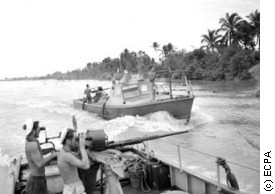 Eighteen of these
patrol boats were delivered by the USA
in 1952. Too
fragile and vulnerable to be used on Vietnamese rivers, the Y Cutters
were restricted to short-range coastal patrols and working the
estuaries of Cochinchina. A few were used to patrol the Cambodian lakes
and rivers where the threat of heavy ennemy action was much lower.
Despite the photo captions in Jim Mesko's Riverine : a Pictorial
History of the Brown
Water War
in Vietnam, none of these craft ever went close to Hoah Binh. Eighteen of these
patrol boats were delivered by the USA
in 1952. Too
fragile and vulnerable to be used on Vietnamese rivers, the Y Cutters
were restricted to short-range coastal patrols and working the
estuaries of Cochinchina. A few were used to patrol the Cambodian lakes
and rivers where the threat of heavy ennemy action was much lower.
Despite the photo captions in Jim Mesko's Riverine : a Pictorial
History of the Brown
Water War
in Vietnam, none of these craft ever went close to Hoah Binh.Displacement : 10 tonnes Length : 12.2 m Width : 3.4 m Draught : 0.70 m Machinery : two Gray Marine 671, 225 hp Speed : 18 knots Crew : ? men Armament : one 20mm gun and one 12.7mm machine gun Requisitioned in 1945 from the Gressier company, these rice barges were converted to "river battleships" by the BMEO workshops and the Saigon Arsenal. Named Dévastation, Foudre (later renamed Tonnerre), Lave, Tonnante, Volcan and Terreur these improvised units usually operated alone either for patrols or in support of land operations. Armament varied from boat to boat according to availability but was mainly made up of prewar Japanese and French weapons. For instance, in 1948, Foudre (shown below) was armed with one 75mm gun, one twin and two single Japanese 25mm guns, two Hotchkiss 13.2mm machine guns, two Hotchkiss 8mm machine, two .303mm machine guns, two 81mm mortars and one 50mm mortar. As more modern boats became available, these barges were returned to their owners except for Lave and Dévastation which were kept to serve as rice convoy escorts in Cochinchina.
Armed Junk [ Top ]
Displacement : 100+ tonnes Vedette FOM 8m
[ Top
]
Vedette FOM 11m [ Top ] Introduced soon after the short FOM boats, the 11 metre version was a much more powerful development. An enlarged armoured kiosk allowed the boat commander to man one of the LMGs or a recoilless rifle nearly 2 metres above water level. One boat in each platoon substituted a 60mm mortar for the rear machine gun turret.
VV (Vedette Vietnamienne) [ Top ]  Used exclusively
by
the Garde
du
Viet-Nam Sud (GVNS) flotillas as part of the Groupe
Autonome d'Escadrilles Fluviales (GAEF), these were
modified LCP(L) (Landing
Craft Personnel, Large). Most of these wooden landing craft were
modified for patrol work along similar lines as the LCVPs
although some remained unarmoured. Armament varied and
ranged from a single 12.7mm HMG on unarmoured craft to one 20mm
Oerlikon gun, three 7.62mm
machine guns and two
rifle grenade launchers on the heavy patrol boats. In May 1949, 24 VVs
were in service (12 armoured and 12 unarmoured boats) in four
flottillas based in Saigon, Mytho, Vinh-Long and Cantho. They were
replaced in 1952 by EAs and LCVPs. Used exclusively
by
the Garde
du
Viet-Nam Sud (GVNS) flotillas as part of the Groupe
Autonome d'Escadrilles Fluviales (GAEF), these were
modified LCP(L) (Landing
Craft Personnel, Large). Most of these wooden landing craft were
modified for patrol work along similar lines as the LCVPs
although some remained unarmoured. Armament varied and
ranged from a single 12.7mm HMG on unarmoured craft to one 20mm
Oerlikon gun, three 7.62mm
machine guns and two
rifle grenade launchers on the heavy patrol boats. In May 1949, 24 VVs
were in service (12 armoured and 12 unarmoured boats) in four
flottillas based in Saigon, Mytho, Vinh-Long and Cantho. They were
replaced in 1952 by EAs and LCVPs.Displacement : 6.5 tonnes Length : 11.07 m Width : 3.30 m Draught : 1.10 m Machinery : one Gray Marine 64HN9 diesel, 225 hp Speed : 8 knots Crew : ? men Transport capacity : ? men Armament : see text CB (Chaland Blindé du Génie) [ Top ]  Operated by Army
Engineer units, these locally-built armoured ferries
were intended to provide river-crossing capabilities where bridge
building was not feasible. Largely comparable to LCM 3s,
20 were planned although only 5 were ever
built and these were used exclusively in Cochinchina before being
replaced by LCMs. Operated by Army
Engineer units, these locally-built armoured ferries
were intended to provide river-crossing capabilities where bridge
building was not feasible. Largely comparable to LCM 3s,
20 were planned although only 5 were ever
built and these were used exclusively in Cochinchina before being
replaced by LCMs.Displacement : ? tonnes PB (Pinasse Blindée du Génie) [ Top ]  Smaller brethren of
the CBs, these armoured pinnaces
were employed in the same way. Generally
comparable to
LCVPs in capability, only five PBs were ever built and operated
alongside the CBs. Smaller brethren of
the CBs, these armoured pinnaces
were employed in the same way. Generally
comparable to
LCVPs in capability, only five PBs were ever built and operated
alongside the CBs. Displacement : ? tonnes
|

 Displacement : 250
tonnes
Displacement : 250
tonnes  Displacement : 140 tonnes
Displacement : 140 tonnes 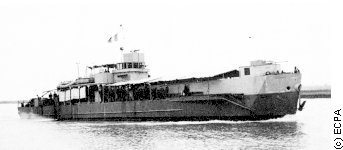 Displacement : 380 tonnes
Displacement : 380 tonnes  Displacement : 380 tonnes
Displacement : 380 tonnes  Displacement : 270 tonnes
Displacement : 270 tonnes  Displacement : 390 tonnes
Displacement : 390 tonnes  Displacement : 47 tonnes
Displacement : 47 tonnes 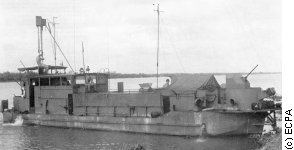 Displacement : 55
tonnes
Displacement : 55
tonnes  Displacement : 52 tonnes
Displacement : 52 tonnes 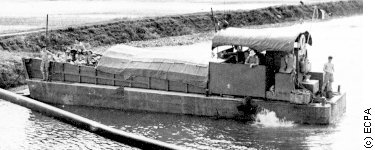 Displacement : 30 tonnes
Displacement : 30 tonnes  Displacement : 35 tonnes
Displacement : 35 tonnes  Displacement : 9 tonnes
Displacement : 9 tonnes  Two of these fire
support versions of the
Two of these fire
support versions of the 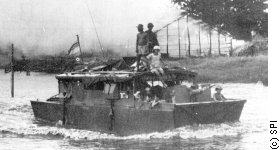 Displacement : 7 tonnes
Displacement : 7 tonnes  Displacement : 10
tonnes
Displacement : 10
tonnes  Displacement : 50 tonnes
Displacement : 50 tonnes  Displacement : 120
tonnes
Displacement : 120
tonnes  Displacement : 70
tonnes
Displacement : 70
tonnes 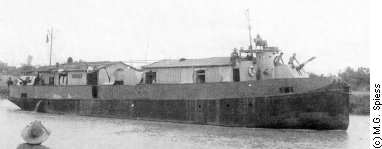 Displacement : 220
tonnes
Displacement : 220
tonnes 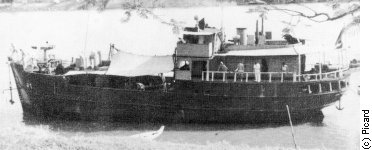 Seven or
eight large motorized junks, some of them previously used by the
Japanese, were reqisitioned in 1945 and used for transport and patrols.
Of course, there was no standardisation of any kind so the data below
is only meant to be representative.
Seven or
eight large motorized junks, some of them previously used by the
Japanese, were reqisitioned in 1945 and used for transport and patrols.
Of course, there was no standardisation of any kind so the data below
is only meant to be representative. 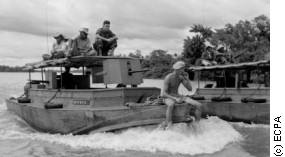 Displacement :
8 tonnes
Displacement :
8 tonnes 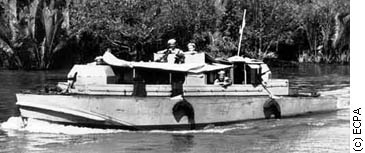 Displacement
: 12 tonnes
Displacement
: 12 tonnes